In an ideal world, setting up your home network would be easy. You’d plug in your modem, connect your router, and you’d instantly have WiFi coverage over the entire house. But not everybody is ideally set up for a single WiFi router. For example, what if you have a ranch home? Because the space is so spread out, that 2,500-square foot may only cover 1,000. In that case, you’re going to need some way of spreading out the signal. There are some options for this, like a mesh WiFi router, but as we’ll see, WiFi isn’t always perfect.
One solution is to use a MoCA 2.5 network adapter. These adapters use your home’s existing coax cables to spread the signal throughout the building. They’re not a perfect solution for every situation. But in the right place, they can turn a shoddy home network into a streaming and gaming paradise.
Today, we’ll be looking at three of the best MoCA 2.5 network adapters for Ethernet over coax. To begin with, we’ll review the Actiontec ECB6250. This adapter offers ultra-fast 2.5Gbps speeds, as well as advanced security features. Next, we’ll look at the goCoax WF-803M. This is another ultra-fast adapter, but lacks the Actiontek’s on-board security features. Then again, it’s significantly more affordable. Last but not least, we’ll examine the Hitron HT-EM4. This is a similar adapter, but with a compact form factor.
Which one is the best? To find out, we’re going to have to take a closer look. We’ll talk about how they work, and how well they’re constructed. But first, we’ll talk about MoCA technology, and why it’s worth considering.
What is MoCA?
MoCA is a relatively new technology designed to compensate for the weaknesses of a WiFi network. There are two separate issues to deal with here: range and latency. Let’s look at each of them in turn.
In many homes, range isn’t going to be a concern. Modern routers are well-engineered enough to cover your typical suburban wood frame house. But not everyone’s home has that type of design. For instance, many homes have interior brick or masonry walls. These can quickly degrade a WiFi signal, especially if the signal needs to penetrate more than one wall. Even with a good router and a high-speed internet plan, your streaming devices can end up struggling.

Another WiFi-related issue is latency. Latency is the delay between a packet arriving at your router and when it arrives at your device, and vice-versa. The lower the latency, the more reliable the signal. High latency, on the other hand, can cause trouble for apps that rely on a consistent, stable signal. This isn’t typically an issue for streaming apps, since the buffer compensates for any slight delay. But it’s a serious problem for online gaming. If you have a latency of 15ms, you’re literally 15 milliseconds behind all of your opponents. Between players of similar skill, that delay can make a big difference.
MoCA is short for Multimedia over Coax Alliance. Like many connection standards, this alliance is a group of tech companies who have come together in mutual self-interest. By establishing a single standard, manufacturers ensure that all MoCA hardware will be compatible. MoCA is designed to provide lower latency than WiFi, and to get around wireless range limitations. It’s able to do this because it uses a wired connection, which is more reliable by its very nature.
To be fair, you’ve always had the ability to install a coax extension cable or switch in your home. But this could involve complex — and expensive — installation. For instance, if your WiFi issues were caused by a stone wall, you’d have to drill through the wall. Meanwhile, if there were existing cables for your cable television, they couldn’t be used for the same purpose.
MoCA technology, on the other hand, allows you to transmit data over your home’s existing coaxial cables. If you have a wall jack with a TV in your bedroom or office, you can convert it into an internet cable. More importantly, you can do this without interfering with your TV’s existing signal. This means you can get a high-quality, wired signal just about anywhere in your home. And new MoCA 2.5 technology allows for speeds as high as 2.5Gbps. This makes them fast enough for all of your streaming needs.

Why Not Just Use Mesh WiFi?
A mesh WiFi system is an alternative way of expanding your network’s range. A mesh network consists of two or more router units that serve as part of the same network. By using multiple overlapping units, the mesh router extends your range significantly. This is a particularly popular solution for offices and other commercial spaces. However, there are a couple of reasons that mesh routers aren’t always the best solution for residential purposes.
For one thing, you may be a gamer, or may have other needs that require low latency. In that case, a mesh WiFi router isn’t going to help you. You’ll still be dealing with the same fundamental issue as any other WiFi router: the nature of the signal itself. There’s going to be latency, whether you’re on a mesh network or a standard one.
Another reason mesh systems aren’t always ideal is that they’re still subject to obstacles like walls. When they’re used in large, open commercial spaces, there aren’t a whole lot of things in the way. They’re considerably less useful when you’re in a house with a bunch of obstacles. That said, there are some situations where a mesh network can work just fine. For example, in the large ranch home we mentioned earlier, it could cover a lot of square footage.
There’s one other reason you might want to use a mesh router instead. MoCA adapters aren’t compatible with all types of home networks. If you have a satellite TV provider, for example, they won’t work. The same is true for AT&T internet, or AT&T U-verse home networks. If you use one of those services, a mesh router will be your only option.
If you want to get the best of both worlds, you can use a pair of MoCA adapters. Put a WiFi network extender on one end, and you can still connect your wireless devices. You’ll have top-speed WiFi, along with a low-latency wired connection.
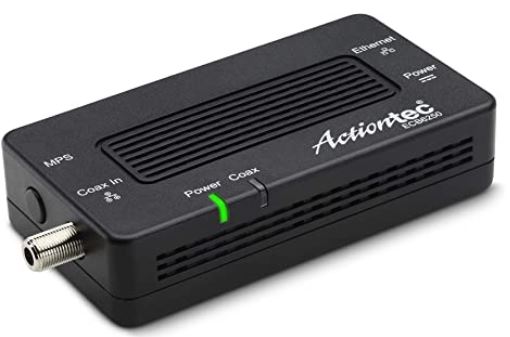
Actiontec ECB6250
Actiontec is an established brand that produces a variety of networking equipment. In the past, we’ve reviewed some of their wireless extenders, and they performed quite well. So we were ready and willing to give their ECB6250 network adapter a chance.
This is an all-in-one adapter that converts your Ethernet signal to coax, or vice-versa. It also has a pass-through for your TV signal, so you can keep your television connected. The main unit is a rectangular box, measuring 4.4 inches long, 2.2 wide, and 1.1 deep. It’s made of black ABS plastic, with vents along the top and sides. These vents ensure that it remains cool during operation, and won’t get overheated. On the top, there’s a printed white Actiontec logo, alongside a pair of green LED indicator lights. These indicate when there’s an active power and coax connection respectively.
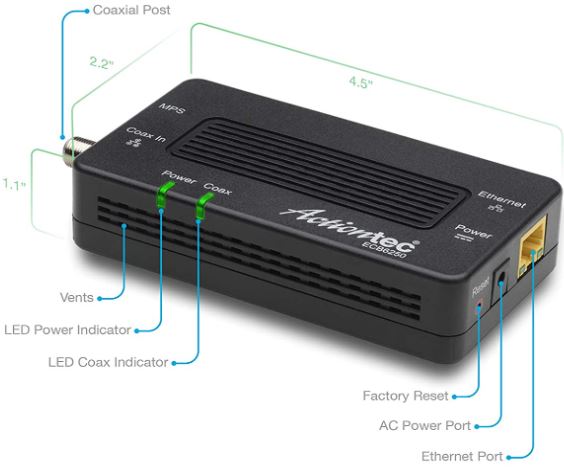
At one end, there’s a bright yellow Ethernet port, as well as a DC power input and a small reset button. At the other end, there are a pair of male coax connections. The first of these is for connecting to your wall jack, while the other is your TV bypass. All the ports are labeled, so you won’t have any confusion over which is which. There are also cables included with the kit. These include an Ethernet cable, a coax cable, and an AC power adapter. All of this is covered by a 12-month manufacturer’s warranty.

The MoCA connection is made to form a bridge between two or more network adapters. This backbone connection has a maximum bandwidth of 2.5Gbps. However, individual devices max out at 1Gbps, or standard Ethernet speed. The higher backbone bandwidth simply allows for more devices to be using the network simultaneously. In other words, if you’re streaming Netflix in one room, someone else can be playing online games with no trouble. So instead of connecting a single device, the ECB6250 is also suitable for connecting several.
In addition to all this, Actiontec has built MoCA Protected Setup (MPS) into the system. This is similar to WiFi Protected Setup (WPS), in that it allows for a secure, push-button connection. This makes the ECB6250 suitable for shared networks as well as home networks. If the WPS button is not pushed on your end, other MoCA adapters cannot be paired. That said, unlike some MPS systems, your router doesn’t have to be reconfigured when new units are paired. This advanced security makes it easier to set up and install new adapters.
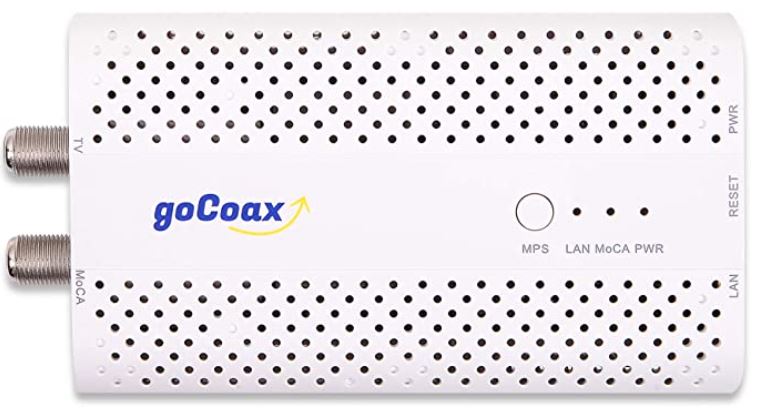
goCoax WF-803M
The goCoax WF-803M is significantly different from the Actiontec in terms of physical appearance. It’s constructed from white plastic instead of black, and has an oval profile instead of square. The MPS button is located on the top, alongside a trio of indicator lights. These alert you to the status of the power, MoCA, and LAN connections respectively. Vents are arranged both above and below the buttons and lights, providing for plenty of airflow. Much like the Actiontec adapter, the inputs and outputs are arranged on two sides. On the right, you’ll see the Ethernet, power, and a reset button. On the other side, you’ll see the two coax jacks. These all work the same as the Actiontec’s.
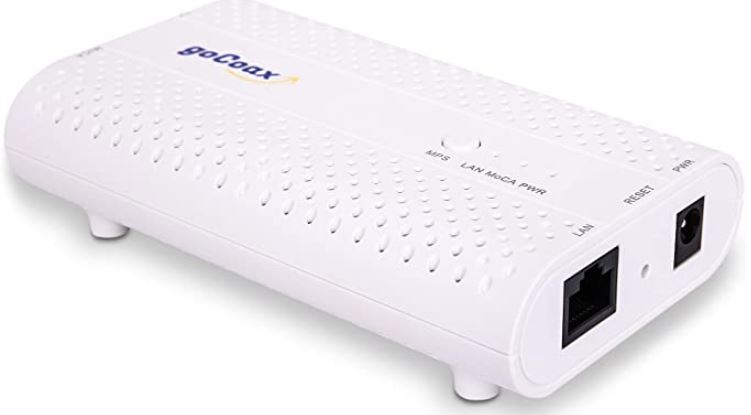
Along with the adapter itself, you get a coax cable, an Ethernet cable, and a power adapter. Just plug into your existing wall jacks, connect TV cables on either end, and you’re ready to go. The speed is the same as the Actiontec adapter, with a 2.5Gbps backbone and 1Gbps connectivity at either end. That’s more than fast enough for all your modern devices and streaming services. Latency is also very good, at a maximum of 3ms. The only downgrade here is the MPS setup function, which isn’t as advanced as the Actiontec. But considering how affordable the goCoax adapter is, that’s a small sacrifice to make.
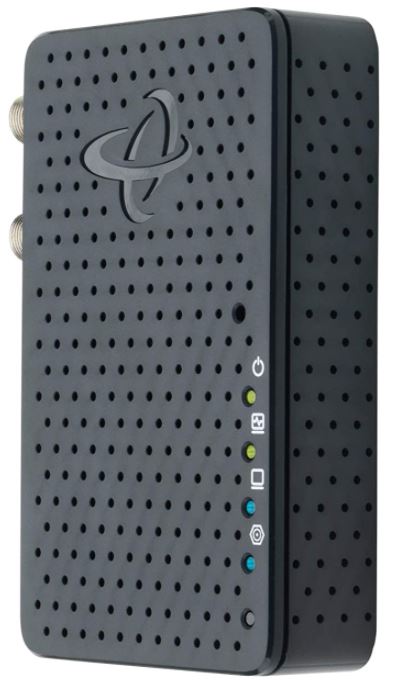
Hitron HT-EM4
The Hitron HT-EM4 is similar in design to the Actiontek, with a matte black housing. We were particularly impressed with the quality of the ventilation, with holes on all six sides. This means you don’t have to worry about placement from an airflow perspective, as some vents will always be visible. The housing is very slim, at just under an inch in thickness. The other dimensions are also compact, at 4.25 inches in length and 2.75 inches in width.

The overall configuration is a bit different from the last two options, though. Instead of connections on the two ends, they’re all located on the back. This makes the unit easier as a tabletop or desktop unit, rather than an inline adapter.
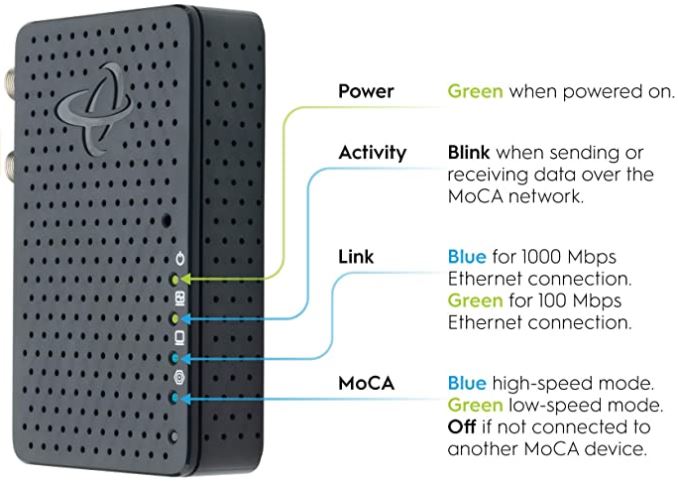
It will still provide the same reliable 2.5Gbps backbone and Ethernet speeds, though. There are also cables included in the kit, so you’ve got everything you need in order to get started.
Final Verdict
As you can see, the main difference between these three network adapters is their security capabilities. Specifically, the Actiontec ECB6250 has advanced security, while the others do not. Still, the goCoax WF-803M and Hitron HT-EM4 have benefits of their own. At a much lower price than the ECB6250, they provide most of the same other benefits. You get stable, 1Gbps connections for your devices, with a generous 2.5Gbps backbone connection.
MoCA adapters aren’t for everybody. But if you have existing coax wiring and you’re experiencing WiFi trouble, they can be just what you need. Any of these three contenders would be a solid choice.
Meet Ry, “TechGuru,” a 36-year-old technology enthusiast with a deep passion for tech innovations. With extensive experience, he specializes in gaming hardware and software, and has expertise in gadgets, custom PCs, and audio.
Besides writing about tech and reviewing new products, he enjoys traveling, hiking, and photography. Committed to keeping up with the latest industry trends, he aims to guide readers in making informed tech decisions.


Thanks for the overview. However, the Hitron HT-EM4 is the only one of the three with two coax jacks.
One location I am looking at using this is in my office. I have three Ethernet devices that I have connected to an Ethernet switch. It is also where the modem and router are. My thought was to use the splitter with one output going to the modem that connects directly to the modem. The other end of the splitter will connect to the MoCA 2.5 adapter then connect that to the Ethernet switch.
The second location is a simple, coax wiring into a bedroom to the MoCA 2.5 adapter then Ethernet to a smart TV.
Is this a correct and best solution for what I have described?
Thanks! This is very helpful in making my pick. Is it possible to mix and match MOCA adapters?
MoCA is a standard. You can mix adapters of any brand and type and MoCA version The speed is limited by the MoCA version. You will reach the highest speed when two MoCA 2.5 adapters work together.
Can you use a MoCa 2.0 adapter on a MoCa 2.5 network? Even expecting lower than 2.5 speeds?
@Paul not sure the use of the splitter here. What you should do is router/modem –> Ethernet cable connected to Moca –> coax cable connection from moca to rest of house –> another moca device where you want to have another wired connection with coax connecting to the moca and then Ethernet out from there to whatever devices you need